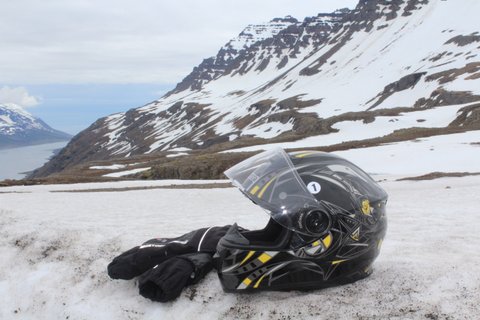Northern Exposure...
an Icelandic motorcycle saga
John Newman
The messages into my mobile marked my progress on the road: Welcome to France, Belgium, Holland, Denmark. Then my progress at sea: Welcome to Faroe Islands, Iceland.
I'd contemplated a motorcycle journey to Iceland for some time. The landscape fascinated me; an island nation close to the Arctic Circle, one of earth's most northerly populated land masses with a rugged coastline measuring some 3,000 miles (4,800kms), and a population of around 330,000 mostly clustered around Reyjkavik the capital.
Plenty of old geysers
Volcanoes, glaciers, waterfalls by the score, geysers, hotsprings, lava deserts, rivers and torrents of water everywhere. Just one main road encompassing the island, the N1, around 875 miles in total (1400kms), and known as 'The Ring'. It's the route most tourists plan their trip around, and most of the easily accessible geographic sites are reachable from it. But Iceland also has a network of 'gravel' roads reaching into the remote interior, and out to the peninsulars that push out towards the Arctic Circle and Greenland to the north and north west.
Great bike for an Adventure
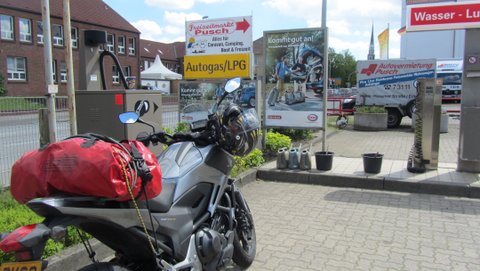
A pit stop in Germany
These were some of the roads I wanted to ride, and Honda helped me do this by loaning one of the bikes from their 'Adventure' range, the NC750X. It would be a real test for this bike's ability to cover big mileage as well as tackling challenging terrain. Because the only way to get to Iceland with your own vehicle is on board a ferry from the northern Danish port of Hirshals. And as there are no longer any ferries across the North Sea to Denmark, it means a long ride starting from Calais or Rotterdam. I chose to cross the channel to Calais: it's 790 miles from there to Hirshals, but I didn't intend to squeeze too much speed out of myself and the parallell twin 750cc. I overnighted in Holland, southern Denmark, and then the lively town of Aalborg in the north before heading to sea.

Honda NC750X
When I collected the bike from Honda's press workshop, Matt their technician explained that this was the dual clutch 'automatic' model, and carefully explained the drive options. It was unusual to say the least, to be taking over a bike of this nature with no gear lever and no clutch.
Here's how it works. In Drive mode the bike selects the six gears automatically. You can choose Sport mode for power with far more zip if your ride mood is for a faster experience and will encounter more bends and roundabouts. The third option is going to manual. Still no clutch or gear lever required, you use a finger and thumb to change up or down via a handlebar switch, much the same way of the set up in Formula One cars.
You can also use the finger control to change down a notch when in Drive mode if you are making an overtake and need more power to get past quickly (and safely). Matt also acquainted me with the fuel filler which is under the pillion seat. A minor inconvenience as far as I was concerned as I was toting an Ortlieb waterproof bag which would be bungeed onto that space. On the plus side the dummy fuel tank allows a whole bunch of stuff to be stored. Giving me easy access to my camera, maps, visor cleaning spray, emergency kit – spare bungee, cable ties, gaffer tape, notebook and paperwork.
Ships that pass in the night
The queue for the ferry was enlivened by an Italian rider brewing up fresh coffee from his camping kit. In a stereotypical move he offered some to the most attractive woman rider among us. Another rider recognised my UK number plate and struck up a conversation. He had journeyed from Switzerland on his Yamaha Xmax scooter; a 400cc. He chose this over his F650 BMW because it was more comfortable. The majority of riders amongst the twenty or so gathered were from Germany, and predictably on board a variety of big BMW GS's laden with Touratech and Wunderlich travel accessories. But the most interesting vehicle was a BMW/Wasp outfit with the sidecar acting as a luggage carrier for camping gear.
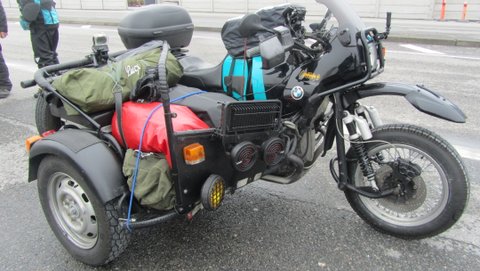
A very practical set up
We drove into the bowels of the ship to be met by a distinct odour...fish. No surprise really as articulated trailers were being loaded and unloaded, presumably containing the main export from the Faroe Islands and Iceland. The crew lashed the bikes firmly to the deck, a portent of the weather we might expect in the exposed part of the journey across the north Atlantic. We would be at sea for three nights, covering 853 (nautical) miles before we docked on the east coast of Iceland at Seyjisfjordur.
Whale meet again, who knows where, who knows when?
This not a cheap ferry ride, and I'd opted for the cheapest option, which is to share a cabin with three other blokes travelling solo. It was a strange experience sharing such a cramped and 'intimate' space with people who you'd never met before and may never see again. If ever I am incarcerated at the pleasure of Her Majesty I'll probably enjoy more privacy and space than there was here. I only saw the prone sleeping bodies of two until we were disembarking. The other was a German motorcyclist riding a very nicely set up 2001 Honda Transalp. Our conversation was very limited, and he explained that unlike Germans from the West, in the East where he was schooled they learned Russian as their second language.
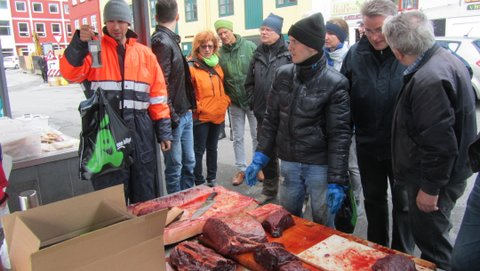
Selling whale meat at Torshavn
The tedium of the ferry crossing was relieved at Torshavn the capital of the Faroe Islands where us passengers were allowed off the ship for a few hours. Unless you like Bingo, eating, drinking and shopping there was not much to do on board except people watch and read. There was a lot of knitting going on and from time to time a flurry of binocular and camera activity when we passed by the Shetland Islands or an oil rig. When I was tired of reading or just bored I reminded myself that thousands of our co-humans spend weeks at sea crowded, starving and not knowing if they will live or die before they reach their 'promised land'.
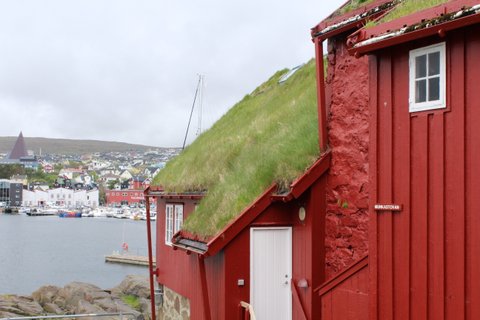
Torshavn
The ship nosed into Seydisfjordur and a 12 mile cruise across shimmering blue waters sheltered by looming black snow flecked mountains. It's a startling introduction to the country's overwhelming landscape, and ample compensation for all those road and sea miles. There was Blue sky overhead, but the captain announced that there was gale force wind blowing from the south west. Too right, it was almost impossible to stand on deck.
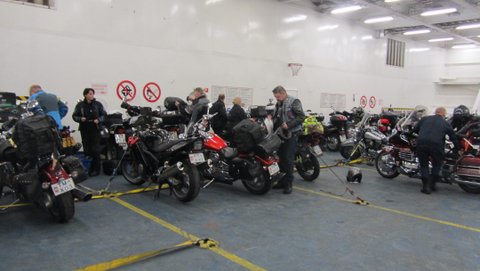
The motorcycle section of the car deck was a hive of anticipatory activity as luggage was re-packed and re-strapped. At Toshavn we'd been joined by half dozen riders from the Faroes. Their opportunities for road time must be very limited given the weather and living on a group of small islands. As I rode off the ship and into the small town I spied a coffee shop and decided to take a late breakfast before riding the 186 miles to my first stop, the northern town of Aklureyri. I had ten days here, and had planned to explore the north of the country rather than scurry around the N1 Ring or visit Reyjavik.
So here ends the first instalment of John's Icelandic saga - just when it was getting interesting - watch this space for what happens next in the land of ice and snow. Next time: The road to Akureyri, nudging the Arctic Circle, brutal and beguiling landscapes, and more about the Honda NC750X.
John Newman
for Wemoto News
[email protected]
